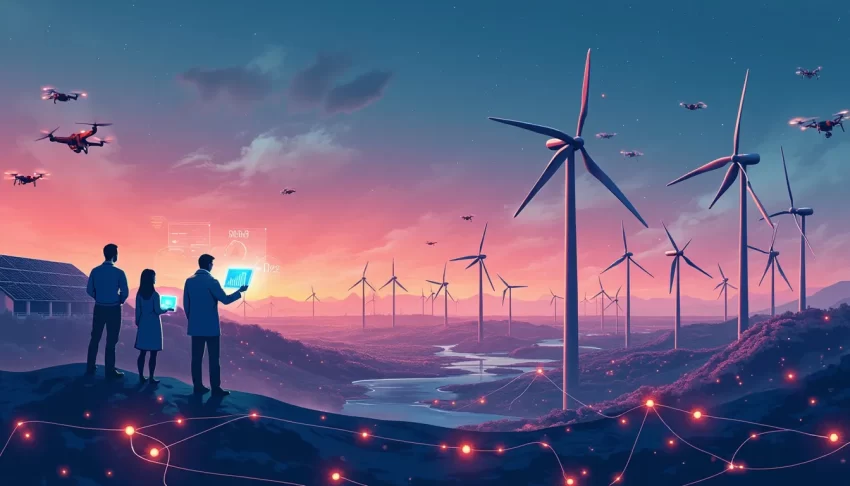In an era where energy demands are soaring and the quest for sustainability is more pressing than ever, AI innovations in the energy sector are forging a path towards a smarter, more efficient, and environmentally friendly future. The current state of the energy sector is characterized by a multifaceted mix of traditional power sources and burgeoning renewable options. Nevertheless, with the global push towards reducing carbon footprints and enhancing energy efficiency, there is a palpable need for advanced technologies like Artificial Intelligence (AI) to revolutionize how we manage our energy resources.
Historically, the energy sector has relied heavily on legacy systems and conventional methods to balance supply and demand—a juggling act that often leads to inefficiencies and wastage. This is where AI steps in as a transformative force, offering a plethora of solutions ranging from predictive analytics for advanced energy forecasting to smart grid technologies designed to optimize distribution and minimize losses. AI innovations in the energy sector are not merely theoretical; they are actively reshaping operational landscapes, heralding an era of precision and sustainability.
Imagine a world where energy systems autonomously adapt to consumption patterns, a world where renewable energy sources are seamlessly integrated and managed to their maximum potential. This is the promise of AI-driven solutions, capable of transforming raw data into actionable insights, optimizing storage and distribution, and even forecasting weather patterns to better harness renewable energy. For instance, imagine your utility company not only predicting peak usage times but also dynamically adjusting to mitigate energy waste. AI innovations in the energy sector extend beyond mere efficiency; they pave the way for an intelligent, responsive energy network.
In the coming sections, we will dive deeper into specific areas where AI is making significant impacts. From enhancing energy efficiency through predictive analytics to the development of smart grid solutions and beyond, the scope of AI’s transformational potential is vast. We will also explore case studies of successful AI implementations, shedding light on real-world benefits and the tangible improvements observed by industry leaders. Whether it’s through reducing carbon footprints in renewable energy projects or optimizing grid management, the positive impacts are undeniable.
As we look towards the future, it’s clear that the journey of AI innovations in the energy sector is just beginning. Emerging AI technologies hold immense promise, yet the path forward is not without its challenges. Issues related to technology adoption, data privacy, and regulatory compliance will need to be navigated with care. However, with the right policies and frameworks in place, the energy sector stands poised to fully harness the revolutionary potential of AI.
So, whether you’re an industry professional, a policy maker, or simply an energy-conscious individual, staying informed and engaged with these technological advancements is crucial. As we explore these transformations, may we collectively drive towards a more efficient, sustainable, and intelligent energy future.
Introduction to AI Innovations in the Energy Sector
The energy sector, a cornerstone of modern economies, is currently facing unprecedented challenges and opportunities. Driven by the dual need to meet growing energy demands while mitigating climate change, this sector stands at a pivotal point. Traditional energy management systems, which have long relied on predictable consumption patterns and fossil fuels, are increasingly inadequate in the face of dynamic needs and the urgent push for sustainable solutions. Thus, the advent of advanced technologies heralds a new era—one in which Artificial Intelligence (AI) plays a transformative role.
Understanding the current state of the energy sector requires a look at its evolving landscape. Conventional energy generation methods, primarily based on non-renewable sources like coal, oil, and natural gas, are now juxtaposed with renewable alternatives such as solar, wind, and hydroelectric power. This transition, while promising, introduces complexities in energy management. Traditional grids must contend with the intermittent nature of renewables and the integration of decentralized energy sources. This is where the need for advanced technologies comes into sharp focus.
Enter AI innovations in the energy sector. AI’s role in this transformation cannot be overstated. By leveraging machine learning algorithms, predictive analytics, and smart technologies, AI offers unprecedented capabilities to optimize energy production, enhance grid reliability, and promote sustainable practices. For instance, AI’s predictive analytics can forecast energy demand with remarkable accuracy, enabling more efficient energy distribution and reducing wastage. This is particularly crucial in a world where energy affordability and sustainability are paramount concerns.
Consider the story of a major utility company grappling with peak demand periods. Traditionally, this would lead to either overproduction, resulting in wasted energy, or underproduction, causing blackouts. By employing AI-driven predictive analytics, the company can accurately anticipate consumption patterns, ensuring the right amount of energy is produced at all times. This not only stabilizes the grid but also maximizes the use of renewable sources.
Smart grid technologies exemplify another breakthrough in AI innovations in the energy sector. Smart grids leverage AI to make real-time decisions about energy distribution, monitor grid health, and respond to outages more swiftly. For example, AI can quickly identify faults in the grid, isolate them, and reroute power to maintain uninterrupted service. This intelligent management reduces downtime and enhances the resilience of energy infrastructure, which is critical in the face of natural disasters and cyber threats.
Moreover, AI is instrumental in advancing renewable energy solutions. Machine learning algorithms analyze weather patterns to predict solar and wind power generation, thereby enabling better integration of these renewable sources into the energy mix. AI-driven systems can also optimize the placement of solar panels and wind turbines for maximum efficiency. Such precision ensures that renewable energy projects deliver the highest possible return on investment while minimizing their environmental impact.
Beyond energy generation and grid management, AI innovations in the energy sector extend to storage and distribution. Energy storage systems, such as batteries, are crucial for balancing supply and demand, especially with the intermittent nature of renewables. AI optimizes the use of these storage systems by predicting peak usage times and ensuring energy is stored and released in the most efficient manner possible. This not only enhances energy security but also helps in stabilizing energy prices.
Consider the example of a city transitioning to a renewable energy-centric model. By employing AI technologies, city planners can integrate a variety of energy sources, from rooftop solar panels to large-scale wind farms, into a cohesive and efficient system. AI ensures that energy is stored during periods of low demand and released during peak times, thereby maintaining a constant and reliable energy supply. This integrated approach is vital for the success of such ambitious energy projects and showcases the transformative potential of AI in revolutionizing the energy sector.
In summation, AI innovations in the energy sector are not mere incremental improvements but fundamental shifts that promise to reshape the fabric of energy management. From enhancing grid reliability to driving renewable energy solutions, AI stands at the forefront of this revolutionary change. As we advance, the continued integration of AI into the energy sector will be pivotal in addressing the dual challenges of sustainability and efficiency, paving the way for a brighter and more sustainable future.

Key Areas Where AI is Making an Impact in the Energy Sector
AI innovations in the energy sector are sweeping changes across various domains, leading to unprecedented efficiency and sustainability. Let’s explore some key areas where AI’s transformative power is making the most significant impact.
Enhancing Energy Efficiency Through Predictive Analytics
One of the remarkable applications of AI innovations in the energy sector is enhancing energy efficiency through predictive analytics. Imagine the traditional reactive approach to energy management – it often involves addressing issues after they’ve occurred. In contrast, AI-driven predictive analytics harness historical and real-time data to forecast potential problems and optimize energy use ahead of time.
For example, consider a manufacturing facility plagued by frequent machinery breakdowns, leading to inconsistent energy consumption. By employing AI algorithms, the facility can predict machinery failures before they happen. This preemptive strategy not only minimizes downtime but also ensures that energy resources are utilized optimally, significantly lowering operational costs and carbon footprint. As someone who meticulously plans to manage my ADHD and OCD, I can appreciate the foresight AI provides in maintaining balance and efficiency.
Smart Grid Technologies and Their Benefits
Smart grids epitomize how AI innovations in the energy sector can revolutionize energy distribution. Unlike traditional grids, smart grids incorporate AI to enable real-time monitoring, automation, and two-way communication between utilities and consumers. This paradigm shift is crucial for addressing energy demands efficiently and integrating renewable energy sources effectively.
Take, for instance, a bustling metropolitan area where energy demand fluctuates unpredictably. Traditional grids struggle to manage such variability, often leading to energy wastage or shortfalls. However, with AI-driven smart grid technologies, utilities can dynamically balance supply and demand. AI algorithms analyze consumption patterns and adjust energy distribution accordingly. Moreover, this adaptability also paves the way for integrating decentralized energy resources like solar panels and electric vehicles, making the entire system more resilient and sustainable.
Living with ADHD has taught me the importance of dynamic adaptability in managing daily tasks, much like how smart grids must adapt to ever-changing energy landscapes to perform optimally.
AI-Driven Renewable Energy Solutions
The quest for renewable energy is a cornerstone of sustainable development, and AI innovations in the energy sector are pivotal in advancing this cause. AI algorithms are deployed to enhance the efficiency and reliability of renewable energy sources such as solar, wind, and hydroelectric power.
Consider the case of wind farms, where forecasting wind patterns with precision is critical for maximizing energy output. Traditional methods of prediction often fall short, leading to inefficiencies. AI-driven solutions, however, utilize vast datasets encompassing weather conditions, historical performance, and environmental factors to deliver highly accurate forecasts. These insights enable operators to optimize turbine settings, align maintenance schedules, and ultimately, harness more energy.
Similarly, solar power plants benefit from AI through enhanced monitoring and predictive maintenance. By analyzing data from thousands of solar panels, AI can predict malfunctions and suggest preventive actions, ensuring consistent and maximum energy production. Just as I’ve learned to track and predict my behavior to manage my condition effectively, AI ensures that renewable resources perform at their peak.
Optimizing Energy Storage and Distribution with AI
Energy storage and distribution are pivotal areas where AI innovations in the energy sector are creating a substantial impact. Efficient storage solutions are essential for mitigating the intermittent nature of renewable energy and ensuring a steady supply. AI plays a crucial role by optimizing energy storage operations and enhancing distribution networks.
For instance, battery storage systems rely on AI to optimize charging and discharging cycles. By analyzing energy demand forecasts, weather patterns, and historical usage data, AI algorithms decide the best times to store or release energy. This not only extends battery life but also ensures that energy is available during peak demand periods, reducing reliance on fossil fuels.
Moreover, AI improves the distribution of stored energy across the grid. Traditional distribution methods often lead to bottlenecks and inefficiencies. With AI, however, energy distribution becomes a smart process. AI algorithms pinpoint exactly where energy is needed most and reroute it efficiently, reducing transmission losses and enhancing grid reliability.
Living with OCD has instilled in me the significance of optimizing routines to achieve balance, similar to how AI optimizes energy storage and distribution to maintain grid stability and efficiency.
In summary, the integration of AI innovations in the energy sector across predictive analytics, smart grids, renewable energy solutions, and energy storage and distribution is not just transforming how we manage energy but also propelling us towards a more sustainable and reliable future. By embracing these cutting-edge technologies, we can address current energy challenges and pave the way for a greener tomorrow.

3. Case Studies: Successful Implementations of AI Innovations in the Energy Sector
AI innovations in the energy sector have already made significant strides, transforming operations, efficiency, and sustainability in remarkable ways. In this section, we will explore three compelling case studies that highlight the tangible benefits brought about by AI-driven solutions.
Case Study of a Leading Energy Company Leveraging AI for Improved Operations
One notable example of AI innovations in the energy sector comes from a major European energy company, which integrated AI technology to enhance their operational efficiency. Facing high variability in energy demand and supply, this company turned to AI to optimize their energy management processes.
The AI system implemented predictive analytics to forecast energy consumption patterns with high accuracy. By analyzing vast amounts of historical and real-time data, the AI model could predict peak demand periods and suggest preemptive actions, such as adjusting energy production rates or activating alternative energy sources. As a result, the company not only reduced energy wastage but also significantly lowered operational costs.
An interesting anecdote from this case involves a particular week where the AI system detected abnormal consumption patterns in a regional grid. It flagged potential issues stemming from a faulty substation transformer. Early detection enabled the company to perform timely maintenance, averting a major blackout. This episode underscores the invaluable role of AI in ensuring grid reliability and operational continuity.
Impact of AI on Reducing Carbon Footprint in Renewable Energy Projects
Another significant case study focuses on a large-scale solar farm in the southwestern United States that sought to minimize its carbon footprint. To achieve this, the project incorporated AI innovations in several key areas, from energy generation to predictive maintenance.
AI algorithms were employed to monitor the performance of solar panels continuously. By leveraging machine learning, the system could identify underperforming panels caused by dirt, shading, or equipment degradation. The AI provided actionable insights for targeted cleaning schedules and maintenance tasks, which subsequently improved the overall efficiency of the solar farm.
Moreover, AI-driven analytics facilitated better energy storage management. By predicting periods of peak sunlight and potential weather disruptions, the solar farm optimized its battery storage usage, ensuring that excess energy was stored efficiently and utilized during low production times. This strategic approach not only maximized energy output but also contributed substantially to reducing the project’s carbon footprint.
As an engaging story, during one particular quarter, the AI system forecasted an intense dust storm several days in advance, prompting preemptive panel cleaning and strategic energy storage management. This proactive measure resulted in maintaining near-optimal energy production during the storm, showcasing the robustness and foresight enabled by AI innovations in the energy sector.
Benefits Experienced by Utility Companies Using AI for Grid Management
Traditional utility companies have also reaped considerable benefits from AI innovations in the energy sector, particularly in the realm of grid management. One such utility company in Canada utilized AI technologies to revamp their grid management system, aiming for improved efficiency and reliability.
The AI system implemented was capable of real-time monitoring and analysis of grid parameters such as voltage levels, energy flow, and load distribution. With these capabilities, the system could predict potential faults and system overloads. The AI then recommended adjustments to prevent outages and optimize load distribution across the grid.
The utility company reported a significant decrease in unplanned outages and faster recovery times from any disruptions that did occur. The AI’s predictive maintenance capabilities allowed for timely interventions, reducing both the frequency and duration of downtime.
Notably, during a harsh winter season, the AI system’s advanced analytics predicted a severe strain on the grid due to increased heating demands. It suggested load-balancing measures and targeted energy conservation efforts, effectively mitigating the risk of widespread outages. This proactive approach not only improved grid stability but also enhanced customer satisfaction and trust in the utility provider.
These case studies illustrate how AI innovations in the energy sector are not mere theoretical possibilities but are actively reshaping the landscape of energy production, distribution, and management. As we continue to push the boundaries of AI technology, the energy sector stands to gain even more in terms of efficiency, reliability, and sustainability.

Future Prospects and Challenges of AI in the Energy Sector
The potential of AI innovations in the energy sector is vast, offering an array of possibilities that can reshape how we produce, store, and consume energy. As the industry stands on the brink of a technology-driven transformation, the future presents both exciting prospects and notable challenges that need to be addressed to fully realize the potential of artificial intelligence.
Emerging AI Technologies with Potential to Further Revolutionize the Sector
The landscape of AI is continuously evolving, with emerging technologies poised to bring unprecedented changes to the energy sector. For example, advancements in machine learning algorithms can significantly enhance predictive maintenance for energy infrastructure. By analyzing vast amounts of data from sensors and operational records, AI can predict equipment failures and optimize maintenance schedules, reducing downtime and operational costs.
Moreover, AI-powered robotics is another area with promising prospects. Drones and autonomous robots equipped with advanced AI can inspect energy assets—such as pipelines, wind turbines, and solar panels—more efficiently and safely than human workers. These innovations not only improve operational reliability but also offer new levels of cost-effectiveness.
As a case in point, consider the role of AI in enhancing the efficiency of renewable energy sources. Artificial intelligence can enhance the operation of solar and wind farms by predicting weather patterns and adjusting energy output accordingly. This optimization ensures maximum energy capture and minimizes losses, exemplifying how AI innovations in the energy sector can drive greater efficiency and sustainability.
Challenges and Risks Associated with AI Adoption in Energy Management
Despite the promising prospects, the adoption of AI in the energy sector is not without its challenges. One of the key hurdles is the significant investment required to integrate AI technologies. Upgrading legacy systems, deploying new AI-powered solutions, and training staff to handle these advanced tools demand substantial financial resources. For smaller energy firms, these costs can be prohibitive.
Data security and privacy concerns also pose substantial risks. The energy sector is a critical infrastructure, and any data breaches or cyber-attacks can have far-reaching consequences. Ensuring the cybersecurity of AI systems and the data they manage is paramount. Companies must invest in robust cybersecurity measures to protect sensitive information and maintain the integrity of AI operations.
Another critical challenge is the potential for AI-induced biases. AI systems are only as good as the data they are trained on. If the training data is biased or incomplete, the AI algorithms may produce skewed results, leading to suboptimal or even detrimental decisions. This can be particularly problematic in areas like energy distribution, where fair and equitable access to resources must be maintained. Addressing these biases requires meticulous attention to data quality and ethical AI practices.
The Role of Policy and Regulatory Frameworks in Supporting AI-Driven Advancements in the Energy Sector
Given the transformative potential of AI innovations in the energy sector, supportive policy and regulatory frameworks are essential in driving their adoption and seamless integration. Policymakers need to foster an environment that encourages innovation while also ensuring that the deployment of AI technologies is safe, ethical, and aligned with public interest.
A well-defined regulatory framework can set standards for data security, operational transparency, and accountability. This can involve establishing guidelines for data handling, mandating rigorous testing of AI systems, and creating mechanisms for monitoring AI-driven operations. For instance, regulations can require energy companies to conduct comprehensive audits of their AI applications to ensure they are free from biases and capable of making fair decisions.
Furthermore, policies promoting investment in AI research and development can accelerate technological advancements. Governments can provide grants and incentives for companies and research institutions working on innovative AI applications in the energy sector. By doing so, they can spur the creation of cutting-edge solutions that drive efficiency, sustainability, and resilience in energy management.
Successful policy implementation will also necessitate collaboration between the public and private sectors. Public-private partnerships can be instrumental in sharing knowledge, resources, and expertise, enabling the development and scaling of impactful AI solutions. Such collaborations can facilitate pilot projects and large-scale deployments that demonstrate the real-world benefits of AI innovations in the energy sector.
In conclusion, while the path to integrating AI in the energy sector is fraught with challenges, the potential benefits are immense. Embracing emerging AI technologies, addressing associated risks, and fostering a supportive regulatory environment will be key to unlocking the full potential of AI in transforming the energy landscape. For stakeholders at every level, the time to act is now—ensuring that the energy sector not only keeps pace with technological advancements but also leads the way towards a more efficient, sustainable, and resilient future.
As we have journeyed through the various facets of AI innovations in the energy sector, it becomes clear that we are standing on the brink of a transformative era. Advanced technologies, especially Artificial Intelligence, are no longer abstract concepts but active components driving efficiency, sustainability, and economic breakthroughs in energy management.
From enhancing energy efficiency with predictive analytics to the implementation of smart grid technologies, AI innovations have unveiled a plethora of opportunities for not only optimizing operations but also establishing a robust, renewable, and resilient energy framework. The successful case studies further illuminate the tangible benefits and impactful changes AI has already imparted. Companies leveraging AI for operations are witnessing unprecedented improvements, while those embracing AI-driven renewable solutions are significantly reducing their carbon footprints. Meanwhile, utility companies are experiencing enhanced grid management, which translates into more reliable and safer power delivery to consumers.
Yet, envisioning the future of AI innovations in the energy sector, we must tread with calculated optimism. Emerging AI technologies promise to push the boundaries even further, allowing for smarter energy storage solutions and more efficient distribution mechanisms. However, underlying this progress are challenges that need careful navigation. Risk factors associated with AI adoption, such as cybersecurity threats and the need for large-scale data integration, cannot be overlooked. The role of policymakers and regulatory frameworks will thus be instrumental in mitigating these risks and facilitating a supportive environment for AI innovations to thrive.
In light of this dynamic landscape, stakeholders across the energy sector should view AI not just as a tool, but as a catalyst for profound change. Investing in AI technologies, advocating for supportive regulations, and fostering an adaptable workforce ready to harness these new tools are essential steps forward. By doing so, we can collectively pave the way for an energy ecosystem that is not only sustainable and efficient but also resilient to the challenges of the future.
To those grappling with the complexities of AI integration, take inspiration from the transformative stories showcased here. Whether you’re a policy maker, a business leader, or a technology enthusiast, your proactive engagement with AI innovations will play a pivotal role in shaping a brighter, more sustainable energy future. Embrace this journey with open eyes and a strategic mindset, and let’s usher in a new era where AI-driven advancements propel the energy sector to unprecedented heights.
Support Us: Check out our recommended products on Amazon.

